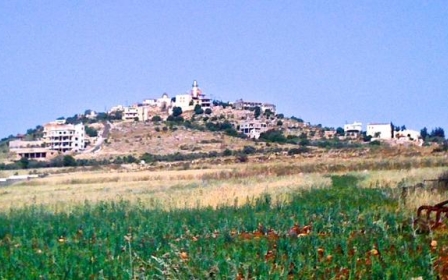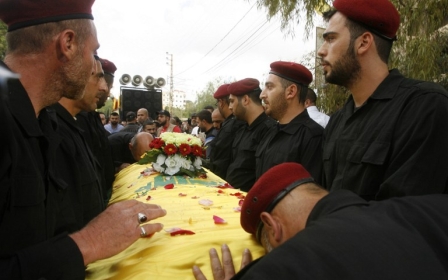Jihad versus jihad: Lebanon's shifting role in regional conflict

Off the coast of the south Lebanese city of Tyre, located close to the border with Israel, a warship recently appeared on the horizon.
Having reflexively feared it was an Israeli vessel, my flatmates and I eventually determined that the boat was merely part of the vast arsenal possessed by the United Nations Interim Force in Lebanon (UNIFIL). Not once did the thought occur to us that the ship might have belonged to the Lebanese military, which is chronically under-equipped.
One reason for the army’s relegation to a bottom-tier fighting force is the domestic political inertia courtesy of sectarian leaders who are loath to see a cross-sectarian institution thrive. Another is that the United States and other concerned parties have in recent history been careful to supply the Lebanese state solely with equipment that does not pose an existential threat to Israel - night vision goggles, for example.
Israel, of course, is permitted to engage in plenty of existential behaviour vis-à-vis its northern neighbour, with the help of all sorts of advanced machinery speedily delivered from the US. In addition to slaughtering civilians, the Israeli army have also regularly targeted installations and personnel belonging to both the Lebanese army and UNIFIL, despite the fact that neither entity is particularly known for lifting a finger against the Israelis, except to compile tallies of Israeli army violations of Lebanese territory and airspace.
Enter Hezbollah, whose battle résumé includes chasing the occupying Israeli army out of Lebanon in 2000, thwarting an Israeli victory during the summer 2006 war, and otherwise humiliating the most powerful military in the region.
The Party of God has since expanded its field of operations, joining the Syrian military in its war against an opposition increasingly dominated by ISIS and other jihadist groups - a move Hezbollah claims is integral to maintaining its resistance capabilities against Israel. Offensive defence, you might call it.
As a result of the jihadist surge, the US & Co have become more generous with the Lebanese army, which has effectively been promoted to the frontlines of the latest war for civilisation and thus deemed a worthy recipient of “top-of-the-line weapons,” as US ambassador to Lebanon David Hale described them in February.
Just this month, the Lebanese army’s official website boasted of an “experimental shooting” session with anti-tank missiles received from the US as part of a Saudi-sponsored deal. Other varieties of incoming material have included helicopter gunships, heavy artillery and Hellfire anti-armour missiles.
These weapons shipments have generated concern in such corners as Israel National News, which recently ran the typically alarmist headline: “Lebanon Gets More US Arms – Or Is It Hezbollah?” In the article, we learn that “many in Israel have expressed fear that those weapons could end up in the hands of arch-terror group Hezbollah”.
A more pertinent question, however, might focus on why Israel has been consorting with the likes of the arch-terror group the al-Nusra Front, al-Qaeda’s affiliate in Syria - or why US weapons have been ending up in the hands of ISIS.
Meanwhile, the whole “enemy of my enemy” logic has continued to fracture in Syria for the West and its allies, given that both Hezbollah and the Sunni jihadists occupy enemy positions. It seems, in fact, that there are now so many enemies that we occasionally lose track of some of them. On 11 June, the Wall Street Journal reported that certain US Senators had complained to Director of National Intelligence James Clapper about an alleged “omission” in a worldwide threat assessment presented to Congress in February.
The problem, in a nutshell, was that “Iran and Hezbollah weren’t included as terror threats”. Indeed, the only time the Party of God is mentioned in the assessment is in the section detailing Lebanon’s “growing threats from terrorist groups”, which notes that “Sunni extremists are trying to establish networks in Lebanon and have increased attacks against Lebanese army and Hezbollah positions along the Lebanese-Syrian border”.
This rendering would appear to cast Hezbollah in a fundamentally defensive role. In response to lawmakers’ complaints, Clapper issued a letter reiterating that both Iran and Hezbollah are still as threatening as ever.
Forget the “enemy of my enemy”; the more enemies there are in circulation, the better it is for the arms industry and other concentrations of power that profit from eternal chaos.
Oddly enough, Lebanon - the state that historian David Hirst has aptly designated the “battleground of the Middle East” - is presently enjoying relative tranquility, as least as far as Lebanese standards go. This despite the chaos next door and repeated insistence from the anti-Hezbollah camp that the Party of God has induced a “spillover” of violence from Syria.
With ISIS now attempting the mother of all spillovers along Lebanon’s northeastern border with Syria, Hezbollah’s function as a last line of defence has become ever more apparent. For all of Israel’s professed desire for regional stability, the Israelis presumably wouldn’t be too torn up if Hezbollah - so often accused of being a “state within a state” - were to be given a run for its money by a caliphate within a state.
And as Lebanon is no doubt condemned to a perennial state of emergency, here’s hoping Hezbollah’s jihad against the jihadists won’t prevent it from multitasking in its next confrontation with the belligerent entity to the south.
- Belen Fernandez is the author of The Imperial Messenger: Thomas Friedman at Work, published by Verso. She is a contributing editor at Jacobin magazine.
The views expressed in this article belong to the author and do not necessarily reflect the editorial policy of Middle East Eye.
Photo: Members of Lebanon's Shiite movement Hezbollah carry the coffin of comrade, Abd al-Jalil Mohamed Hamdan, during his funeral procession, on June 13, 2015, in a southern suburb of the Lebanese capital Beirut after he was killed in combat alongside Syrian government forces in the Qalamun region. (AFP)
New MEE newsletter: Jerusalem Dispatch
Sign up to get the latest insights and analysis on Israel-Palestine, alongside Turkey Unpacked and other MEE newsletters
Middle East Eye delivers independent and unrivalled coverage and analysis of the Middle East, North Africa and beyond. To learn more about republishing this content and the associated fees, please fill out this form. More about MEE can be found here.





